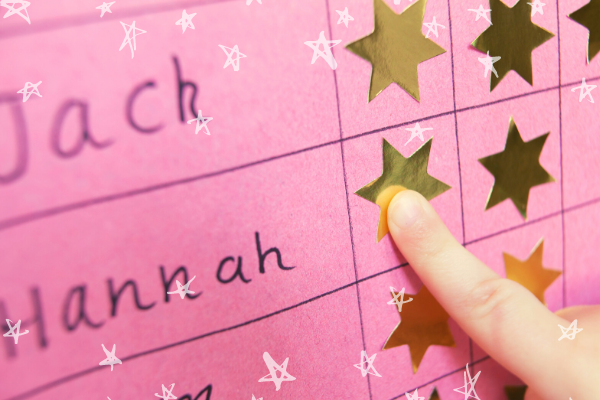How to Improve Behaviour with a Kids Reward Chart

Kids Reward Charts and their merits have the potential to split parents in to the ‘for and against’ camps in the same way that Baby-Led Weaning and Spoon Feeding do.
But, as with all things children and baby, we believe there’s a better middle ground option that takes the best bits of using Children’s Reward Charts, dispenses with the tricky elements, and comes up with a win-win for everyone, sticker and all.
Thoughts Behind Kids Reward Charts
If you’ve gritted your teeth as you cajole your spirited child around the supermarket, or banged your head against their doorframe when you’ve put them back in bed for the umpteenth time, or you just want them, please, to get dressed in the morning without a battle; then Reward Charts can give you hope, control, and a way of positively moving forwards.
Children’s Reward Charts offer you something valuable: currency. Now you have something to work with. Kids Reward Charts flip negativity and punishment on its head, and instead give you something positive to work from.
With a reward chart you’re able to make the tough times easier, and hopefully, change the unwanted behaviour for the better as you go. That’s the theory.

Why Reward Charts Work
It’s Monday morning. You had a great weekend. The alarm blares at 6.30am heralding the start of another hectic week. Now remember that children don’t have the same frame of reference as an adult. The younger they are, the narrower their experience and context for life. They don’t necessarily understand the knock-on effects of taking 27 minutes to put on socks.
In life, there are just some things you have to do, but a reward sweetens the action. Kids Reward Charts work because they make things instant. You’re not waiting until they miss their favourite TV show because the whole day got shifted out of whack by the Sock Disaster.
How to Change Behaviour with a Kids Reward Chart
In order for a Children’s Reward Chart to work, you need to keep a few points in mind:
What Behaviour Are You Trying to Change?
For some children, certainly older ones, things can be more vague and you can have a sticker chart that is suitable for a myriad of general behaviour.
However, for younger children you need to focus on the problem areas. Getting dressed might be your pinch point, or staying in bed at night, or being calm when Mum and Dad go out for the evening. Identify the behaviour.
What’s the Reward?
It seems obvious but you can’t start until you have the reward in place. It needs to be something desired but not extreme. We also particularly like it, especially for little ones, when the reward is in sight, so pop a picture of the reward next to the chart.
The Currency
Whether you’re using stickers, ticks or smiley faces, you need to clearly identify how many are needed to gain the reward. In our experience younger children need to achieve fewer stickers to gain their reward, whereas you can reap success with older children with more stickers or ticks required.
There are a plethora of free printable reward charts available to download featuring all your loved one's favourite children's characters. From Thomas the Tank Engine to Peppa Pig for little ones, or Ninjago to Harry Potter for older children, you can find the latest themed reward charts latest themed reward charts here.
Consistency
Being consistent is key with a reward chart. Each and every time the same action needs to be taken.
Immediacy
Keep the chart visible and update it as soon as the good behaviour is demonstrated. This tallies the good behaviour to the reward.
Shouldn’t My Kids Be Intrinsically Good?
Childhood is about development. Toddlers aren’t exactly known for their natural social etiquette, and moving away from this ego-centric position is a gradual process that takes patience and humour. Sticker charts support that process by providing a carrot, not a stick.
And What About Older Kids?
As children get older, reward charts need to adapt to suit them. It may now be possible to use a children’s reward chart for several, less specific behaviours. The same chart can be tied to doing homework, doing chores, and being kind to a sibling. The key is to keep it relevant.
And if you’ve got a techy whizz kid on your hands, then add an app to their tablet or phone such as the Allowance and Chores Bot and you’ll get them back on track in no time.
Reward Charts – Are They Worth It?
Putting a children’s reward chart in place takes a little forethought and planning. However, when used appropriately, in the context of the child’s age, they can be an invaluable tool for parents.
